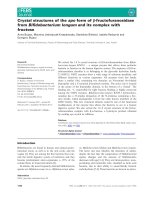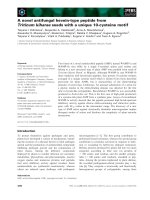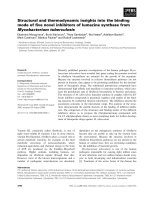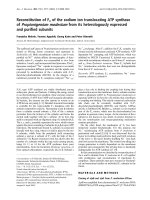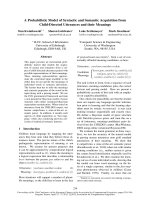Novel bioactivity of furanochromene coumarin from psoralea corylifolia seeds and their synthetic analogues on skin fibroblast cells
Bạn đang xem bản rút gọn của tài liệu. Xem và tải ngay bản đầy đủ của tài liệu tại đây (4.43 MB, 128 trang )
NOVEL BIOACTIVITY OF FURANOCHROMENE & COUMARIN
FROM PSORALEA CORYLIFOLIA SEEDS AND THEIR SYNTHETIC
ANALOUGES ON SKIN FIBROBLAST CELLS
SHIRIDI SAI PRASANNA
M.Sc (Chemistry)
A THESIS SUBMITTED FOR THE DEGREE OF
MASTER OF SCIENCE
DEPARTMENT OF BIOLOGICAL SCIENCES
NATIONAL UNIVERSITY OF SINGAPORE
2010
ACKNOWLEDGEMENTS
Firstly, I would like to express my heartfelt gratitude to National University of
Singapore, for supporting me with their scholarship and facilities without which this
project wouldn’t have happened.
I would like to thank my Supervisor, Dr. Sanjay Swarup, for giving me the
opportunity to work in a very interesting area, and for his support and guidance
throughout my graduate studies.
A special thanks to my Co-Supervisor Dr. Suresh Valiyaveettil, for his insights and
constant guidance throughout the project. I am very thankful to Dr Phan Toan Thang
and Dr Masilamani Jeyakumar for their support and initiating this project.
A million thanks to Dr Priya Ponmudi, who supported me with my experiments
through the hardest times of my project. I also like to thank our lab manager Liew
Chye Fong for being very supportive with the administration work.
My source of inspiration and strength is none other than my mother Dr Bhagavathi
and my family. I am greatly in debt to them for all the love and support they have
given me.
I would like to thank all my lab mates, especially, Weiling, Cui Ching, Amit,
Sandhya, Malar, Balaji, Nizar for not only making the environment in the lab very
homely but also for their help and advice.
Friends! Ayshwarya, Gauri, Karthik Sheela, Satish, Sravanthy and all others for the
moral support and also for the hours spent in discussing science.
i
TABLE OF CONTENTS
ACKNOWLEDGEMENTS ........................................................................................ i
SUMMARY ............................................................................................................ vii
LIST OF FIGURES .................................................................................................. ix
LIST OF TABLES .................................................................................................. xii
LIST OF ABBREVIATIONS ................................................................................. xiii
LIST OF PUBLICATIONS ..................................................................................... xv
Chapter 1 ................................................................................................................. 1
Review of Literature ................................................................................................ 1
1.0 Introduction ......................................................................................................... 2
1.1 Natural Product Chemistry ................................................................................... 2
1.2 Plant-Derived Furanocoumarins and Furanochromenes:....................................... 3
1.3 General characterization of Psoralea corylifolia ................................................... 8
1.4 Seed Constituent analysis..................................................................................... 9
1.5 A link between natural and synthetic worlds ...................................................... 11
1.6 Mode of Action: ................................................................................................ 11
1.6.1 Synthetically - enabled Mode of Action: .............................................. 13
1.6.2 A vital role for total synthesis .............................................................. 13
1.7 Assays for Cell Viability and Proliferation ......................................................... 14
1.8 Potential Application of Furanocoumarins in Wound Healing Process ............... 15
1.8.1 Coumarin-derived natural products ...................................................... 16
1.9 Aims of this project ........................................................................................... 17
Chapter 2: .............................................................................................................. 18
Materials & Methods ............................................................................................. 18
ii
2.0 Introduction ....................................................................................................... 19
2.1 Seed Processing ................................................................................................. 20
2.1.1 Seed Extraction ................................................................................... 20
2.1.2 Reverse Phase High Performance Liquid Chromatography (RP-HPLC)
using Analytical Column.............................................................................. 20
2.1.3 Scale up of RP-HPLC using Semi- Preparative Column ...................... 21
2.2 Purifying and characterizing compound 8b ........................................................ 21
2.2.1 Extraction of solvent from compound 8b by lyophilization .................. 21
2.2.2 Purification of compound 8b by rotavapor ........................................... 22
2.2.3 Structural analysis using Mass Spectrometry ....................................... 22
2.2.4 Nuclear Magnetic Resonance .............................................................. 22
2.3 Purifying and characterizing compound 8f mixture ............................................ 23
2.3.1 Sample preparation for RP-HPLC for further analysis ......................... 23
2.3.2 Further analysis of compound 8f mixture by RP-HPLC ....................... 23
2.3.3 Further analysis of compound 8b and 8f mixture by simple, small scale
thin layer chromatography (TLC) ................................................................. 23
2.3.4 Scale up of TLC by using Preparative TLC ......................................... 24
2.3.4.1 Depositing sample 8b and 8f mixture on TLC plate .......................... 24
2.3.4.2 Identification and collection of different compound on TLC plate .... 24
2.4.1 Maintenance of Skin Fibroblast Cells .................................................. 25
2.4.2 Seeding of fibroblast cells into 96 multiwell plate................................ 25
2.4.3 Qualitative investigation of fibroblast cells .......................................... 26
2.4.4 MTS proliferation assay ...................................................................... 26
2.4.5 Compound 8b and compound 8f drug preparation ............................... 26
2.5 Synthesis of Furanocoumarins: (all reagents were brought from Sigma-Aldrich) 27
2.5.1 Methods for Synthesis of Furanocoumarins ......................................... 27
2.5.1.1 Step 1: Ethyl coumarin-3-carboxylate derivatives ............................. 27
2.5.1.2 Step2: Ethyl 8-bromo-7-hydroxy-2-oxo-2H-chromene-3carboxylate. 27
iii
2.5.1.3 Step 3: Sonogashira reaction procedure: ........................................... 27
2.6 Spectroscopic Characterization: ......................................................................... 28
2.7 Cell Cycle Analysis ........................................................................................... 28
2.8 Confocal Imaging: ............................................................................................. 28
Chapter 3 ............................................................................................................... 30
Results and Discussion .......................................................................................... 30
Isolation, Purification and Structural Elucidation of 9H-furo [3, 2-f] chromene
and coumarin derivatives from Psoralea corylifolia seeds that induce
proliferation of human skin fibroblast cells ......................................................... 30
3.0 Introduction ....................................................................................................... 31
3.1 Purifications of Fc-Compounds Using Reverse Phase HPLC ............................. 31
3.2 Further purification of Fc-8b and Fc-8f using preparative Thin Layer
Chromatography (TLC) technique................................................................ 35
3.3 Quantification of the compounds Fc-8b and Fc-8f .................................. 36
3.4 Structural elucidation of Compound Fc-8b and Compound Fc-8f ....................... 36
3.4.1 ESIMS, 1H, 13C, 2D-COSY NMR studies of FC-8b ............................. 38
3.4.2 ESIMS, 1H, 13C, 2D-COSY NMR studies of FC-8b ............................. 40
3.5 Investigation on Activity of Selected Compounds on Human Skin Cells ............ 42
3.5.1 MTS based assay of Fc-8b on primary human skin fibroblast cells. ..... 42
3.5.2 MTS based assay of Fc-8f on primary human skin fibroblast cells. ...... 43
3.5.3: Concluding Remarks! ......................................................................... 45
Chapter 4 ............................................................................................................... 46
Results & Discussion ............................................................................................. 46
Synthesis and characterisation of Furanocoumarin derivatives and their activity
on skin fibroblast cells ........................................................................................... 46
iv
4.0 Introduction ....................................................................................................... 47
4.1 Rationale behind the synthesis of Furanocoumarin compounds. ......................... 48
4.2 The synthetic scheme for Fc-compounds............................................................ 48
4.2.1 Michael addition reaction to synthesize the coumarin moiety .............. 49
4.2.2 Directed bromination using Br2/AcOH ................................................ 50
4.2.3 Sonogashira coupling .......................................................................... 51
4.2.4 The combined scheme to synthesize Fc-derivatives ............................. 53
4.3 Structural elucidation of Syn1 and Syn2 ............................................................ 56
4.3.1 ESIMS, 1H, 13C, 2D-COSY NMR studies of Syn1 (5) ......................... 56
4.3.2 ESIMS, 1H, 13C, 2D-COSY NMR studies of Syn 2 (6) ........................ 58
4.4 Investigation on Activity of Syn1 (5) and Syn2 (6) compounds on skin fibroblast
Cells ........................................................................................................................ 60
4.4.1 MTS based assay of Syn1 (5) on primary human skin fibroblast cells. . 60
4.4.2 MTS based assay of Syn2 (6) on primary human skin fibroblast cells. . 61
4.4.3 MTS-based assay of combined Fc-8b, Fc-8f, Syn1 (5), on primary
human skin fibroblast cells. .......................................................................... 63
4.5 Imaging of nucleus of stained cells treated with Fc-compounds ......................... 64
4.6 Investigation on molecular effects of compound Fc-8b, Fc-8f and Syn1 on skin
fibroblast ................................................................................................................. 68
4.6.1 Flow Cytometry Measurement of Cellular DNA Content..................... 68
4.6.2 Flow Cytometry analysis of the drugs .................................................. 72
Chapter 5 ............................................................................................................... 74
Significance and Conclusions ................................................................................ 74
v
5.1 Significance and final conclusion: ...................................................................... 75
5.1.1 Stages of cell cycle .............................................................................. 75
5.1.2: The Natural world: ............................................................................. 78
5.1.3: Link to the Synthetic world: ............................................................... 78
5.1.4: Cellular effects of active compounds .................................................. 79
Future Directions ................................................................................................... 80
6.1 Directions 1: Organic synthesis of Fc-derivatives............................................... 81
6.2 Direction 2: Studies on mechanism of action...................................................... 82
REFERENCES ........................................................................................................ 83
APPENDIX ............................................................................................................ 90
vi
SUMMARY
Structures derived from natural products have led to discovery of numerous
drug leads in modern-day drug development process. Here, we report a new class of
compounds that we term Fc-metabolites, reported for the first time from a natural
source. Complete structure of the first furanochromene (9H-furo [3,2–f] chromene;
abbreviated as Fc-8b) and furanocoumarin (abbreviated as Fc-8f) are described based
on
1
H,
13
C, 2D-COSY nuclear magnetic resonance spectroscopy and mass
spectrometer. Furanochromenes are most related to the furanocoumarins class of
compounds. We have developed their purification and identification procedures from
the seeds of the legume plant, Psoralea corylifolia that is found commonly in Asia, to
produce more than 99% pure compounds. More significantly, we report that these Fcmetabolites are highly active in inducing proliferation of primary human skin cells at
concentrations as low as 5 µM. The level of proliferation induced by these compounds
is comparable to that by the universal standard 10% fetal calf serum (FCS) in the
same time-period. We found that therapeutically, these compounds have wide range
of applications but our initial study had few disadvantages such as, these compounds
have short shelf-life period and the concentrations of the active compounds purified
was very low. These disadvantages led us to the second part of our study.
Availability of structural information from these two bioactive Fc-metabolites
shows that the furan and pyran rings are involved in isomerisation. These provide a
structural basis for synthesizing further synthetic bioactive furanochromenes (Fccompounds). Based on the available structure we have developed a novel scheme to
synthesize furanocoumarins and furanochromenes. Using this scheme we have
vii
synthesized two new furanocoumarin derivatives, of which one is active (Syn 1) and
even better in inducing proliferation than natural forms reported here. The cellular
level studies show that these bioactive drugs trigger the proliferations mechanism via
the G2/M phase of the cell cycle.
viii
LIST OF FIGURES
Figure 1.1: Biosynthetic coupling of Dimethylallyl pyrophosphate (DMAPP) and 7
hydroxycoumarin (umbelliferone) giving rise to furanocoumarins .................................4
Figure 1.2: Basic structures of Psoralen and Angelicin...................................................5
Figure 1.3: Other furanocoumarin derivatives from natural sources. ..............................6
Figure 1.4: Biosynthesis and Structures of Furanocoumarins. ........................................7
Figure 1.5: The components of natural product research are divisible into sectors,
including: isolation and structure elucidation (orange), activity screening and
biological studies (red), chemical synthesis (yellow), biosynthesis (blue) and analogue
preparation (green) (James J. La Clair, 2009) ...............................................................13
Figure 1.6: Scheme showing the reduction of MTT to formazan ..................................15
Figure 2.1: Outline of experimental approaches to investigate the effects of selected
constituents from the seeds of Psoralea corylifolia on skin cells. ..................................19
Figure 3.1 (a): RP-HPLC chromatogram of methanolic seed extracts of P. corylifolia
seeds. X axis: elution volume (mL); y axis: UV signal intensity (arbitrary absorbance
units at 254nm). The elution profile is shown in green. (b): Enlarged view of the
chromatogram zone containing the compounds of the bioactive fraction 8b and 8f. .....33
Figure 3.2: Preparative-TLC of Fc-8b and Fc-8f deposited on TLC plate. ....................35
Figure 3.3: (a) The Ball-and-stick model of Fc-8b. (b) Structure of compound 8b
obtained from Mass spectrometry and NMR structural analysis (1H, 13C and 2D
COSY NMR). Atom numbering differs from usual furobenzochromone numbering ....37
Figure 3.4: (a) The ball-and-stick model of Fc-8f. (b) Structure of compound 8f
obtained from Mass spectrometry and NMR structural analysis (1H, 13C and 2D
COSY NMR). Atom numbering differs from usual furobenzochromone numbering ....39
Figure 3.5: MTS-based Proliferation Assay on Human Skin Fibroblast Cells (NF103,
P6) upon Application of Compound Fc-8b. ..................................................................42
Figure 3.6: MTS-based Proliferation Assay on Human Skin Fibroblast Cells (NF103,
P6) upon Application of Compound Fc-8f. ..................................................................43
Figure 4.1: Difference between Furanocoumarin and Furnochromene..........................48
Figure 4.2: Michael addition reaction showing the formation of coumarin ...................49
ix
Figure 4.3: Bromination of ethoxy coumarin (product from step one) ..........................50
Figure 4.4: Sonogashira coupling reaction ...................................................................52
Figure 4.5: Three step synthetic scheme for total synthesis of Fc-derivatives. The final
products Syn1 (5) is shown in red and Syn2 (6) in blue. ...............................................54
Figure 4.6: (a) The ball-and-stick model of Syn1 (5). (b) Structure of synthetic
compound Syn1 (5) obtained from mass spectrometry and NMR spectra (1H, 13C). .....55
Figure 4.7: (a) The ball-and-stick model structure of Syn 2 (6). (b) Structure of
compound Synthetic Syn 2 (6) obtained from Mass spectrometry and NMR spectra
(1H, 13C) ......................................................................................................................57
Figure 4.8: Effect of Syn1 (5) on proliferation of human skin fibroblast cells (NF103,
P6)...............................................................................................................................60
Figure 4.9: Effect of Syn2 (6) on proliferation of human skin fibroblast cells (NF103,
P6)...............................................................................................................................61
Figure 4.10: Effect of Fc-8b, Fc-8f, and Syn1 (5) on proliferation of human skin
fibroblast cells (NF103, P6). ........................................................................................63
Figure 4.11: Confocal laser showing images of PI-stained skin fibroblast cells. (a)
Cells treated with DMEM lacking FCS (b) Cells treated with DMEM+10% FCS.
Cells treated for 48hr with (c) 5µM Fc-8b (d) 5µM Fc-8f (e) 5µM Syn1. These
images are without DIC showing the contrast more clearly. .........................................65
Figure 4.12: Confocal laser showing images of PI-stained skin fibroblast cells. (a)
Cells treated with DMEM lacking FCS (b) Cells treated with DMEM+10% FCS.
Cells treated for 72hr with (c) 5µM Fc-8b (d) 5µM Fc-8f (e) 5µM Syn1. These
images are with DIC to highlight the cell proliferation. ................................................66
Figure 4.13: PI stained flow cytometry assay of human skin fibroblast cells (NF103,
P10) after 24hr treatment with compounds Fc-8b, Fc-8f, and Syn1 respectively...........69
Figure 4.14: PI stained flow cytometry assay of human skin fibroblast cells (NF103,
P10) after 48hr treatment with compounds Fc-8b, Fc-8f, and Syn1 respectively...........70
Figure 4.15: PI stained flow cytometry assay of human skin fibroblast cells (NF103,
P10) after 72hr treatment with compounds Fc-8b, Fc-8f, and Syn1 respectively...........71
Figure 4.16: Cell Cycle regulation by Fc-8b, Fc-8f and Syn1: Propidium iodide based
flow cytometric assay of cell cycle indicated divergent effects of Fc-8b, Fc-8f and
Syn1 on skin fibroblast cells. The phase and time-points at which the drug induces
cell cycle proliferation is highlighted by the oval .........................................................73
x
Figure 5.1: Checkpoints in cell cycle. (Roberts, J. et al, 2003) .....................................76
Figure 6.1: Derivatives that can be synthesised ............................................................81
xi
LIST OF TABLES
Table 3.1: Retention Times of Peaks in RP-HPLC Profile Generated from a SemiPreparative Column .....................................................................................................34
Table 3.2: Retention factor calculated for compound Fc-8b.........................................35
Table 3.3: Retention factor calculated for compound Fc-8f. ........................................36
Table 3.4: 1H and 13C NMR (CH3OD, 300 and 125 MHz) Data of Fc-8b and Fc-8f
compounds ..................................................................................................................40
Table 5.1: Cdks and Cyclins involved at different phases of cell cycle. .......................77
xii
LIST OF ABBREVIATIONS
µ
Micron
µg
Microgram
µl
Microliter
µM
Micromolar
2D-COSY
2Dimensional-Correlation spectroscopy
CDK2
Cyclin Dependent Kinase 2
CDK4
Cyclin Dependent Kinase 4
CDK6
Cyclin Dependent Kinase 6
DMEM
Dulbecco’s Modified Eagle Medium
DMSO
Dimethylsulfoxide
ESI
Electrospray ionisation
FCS
Fetal calf serum
Hr
Hour
M
Molar
Min
Minute
ml
Millilitre
mM
Millimolar
MOM
Methoxy methylactetate
xiii
MTS
3-(4,5-dimethylthiazol-2-yl)-5-(3-carboxymethoxyphenyl)-2-(4sulfophenyl)-2H-tetrazolium
NF
Normal Human Fibroblast Cells
NMR
Nuclar magnetic Resonance
P.I
Propidium iodide
PBS
Phosphate Buffered Saline
PBS
Phosphate buffered saline
PUVA
Psoralen ultraviolet A range therapy
RP-HPLC
Reverse Phase-High Performance Liquid Chromatography
rpm
Rotations per minute
SDS
Sodium dodecyl sulphate
xiv
LIST OF PUBLICATIONS
PATENT
US Patent filed, US Provisional Application No.: 61/322,966. Date: 12 April 2010.
Sanjay Swarup, Masilamani Jeyakumar, Shiridi Sai Prasanna, Phan Toan Thang,
Suresh Valiyaveettil. Furanocoumarins and Furanochromenes that Rapidly Induce
Human Skin Cell Proliferation.
PUBLICATIONS
Shiridi Sai Prasanna, Masilamani Jeyakumar, Thang T Phan, Suresh Valiyaveettil,
and Sanjay Swarup. 9H-furo [3, 2-f] chromene and coumarin derivatives isolated
from Psoralea corylifolia seeds that induce proliferation of human skin fibroblast
cells
(Submitted to Journal of Natural Products, ACS publications, under review).
xv
Chapter 1
Review of Literature
1
1.0 Introduction
1.1 Natural Product Chemistry
A natural product is a chemical compound or substance produced by a living
organism - found in nature that usually has a pharmacological or biological activity
for use in pharmaceutical drug discovery and drug design. A natural product can be
considered as such even if it can be prepared by total synthesis. These small
molecules provide a template or skeleton for the majority of FDA-approved agents
and continue to be one of the major sources of inspiration for drug discovery. In
particular, these compounds are important in the treatment of life-threatening
conditions (Dudler, R et al. 2008).
Plants have always been a rich source of lead compounds some of the classic
examples are morphine, cocaine, digitalis, quinine, tubocurarine, nicotine, muscarine
and didemnin. Many of these lead compounds are useful drugs by themselves (e.g.
morphine and quinine) while others have been the basis for synthetic drugs (e.g. local
anaesthetics developed from cocaine). Plants provide a large bank of rich, complex
and highly varied molecular structures that are unlikely to be synthesized
in laboratories. Furthermore, evolution seems to have already carried out a selective
process whereby plants survival increase based on the presence of anti-herbivory
compounds. Such products deter animals or insects from foraging on plants. Despite
these benefits of plant-derived compounds, the number of plants that have been
extensively studied is relatively very few and the vast majority of plant species have
not been thoroughly studied at all (J. Merrick et al. 1995).
2
1.2 Plant-Derived Furanocoumarins and Furanochromenes:
Furanocoumarins, or furanochromenes, are a class of organic chemical
compounds produced by a variety of plants. They are biosynthesized partly through
the phenylpropanoid pathway and the mevalonate pathway, which is biosynthesized
by
coupling
of dimethylallyl
pyrophosphate
(DMAPP)
and 7
hydroxycoumarin (umbelliferone) (Keggs, 2001) (Figure 1.1 and Figure 1.4). The first
step in the bergapten biosynthetic pathway is the C-alkylation of the ortho-carbon to
phenol. Subsequently, a series of oxidative enzymatic reactions take place.
Benzopyran is an polycyclic organic compound that results from the fusion of
a benzene ring to a heterocyclic pyran ring. According to IUPAC nomenclature it is
called chromene. An additional furan ring attached to chromene becomes
furanochromene. Furanochromene also belong to the same class Furanocoumarin as
both these compounds share the same chromophore.
3
OPP
C-alkylation at activated
position
ortho to phenol
+
HO
O
DMAPP
O
Umbelfenone
HO
HO
O
HO
O
O
NADP
O2
HO
O
O
Demethyl suberosin
NADP
O2
OH
NADP
O2
O
O
O
O
O
psoralen
O
Bengapto
SAM
OCH3
O
O
O
Bengapten
Figure 1.1: Biosynthetic coupling of Dimethylallyl pyrophosphate (DMAPP)
and 7 hydroxycoumarin (umbelliferone) giving rise to furanocoumarins
The chemical structure of furanocoumarins consists of a furan ring fused
with coumarin. The furan may be fused in different ways producing several isomers
(Figure 1.2).
4
O
O
Coumarin Structure: Coumarin is a precursor of furanocoumarins
O
O
O
Psoralen Structure: A linear furanocoumarin.
O
O
O
Angelicin Structure: An angular furanocoumarin.
These are precursor to many members of furanocoumarin family.
Figure 1.2: Basic structures of Psoralen and Angelicin
The compounds that form the core structure of the two most common isomers
are Psoralen and Angelicin (Fig 1.3). Derivatives of these two core structures are
referred to respectively as linear and angular furanocoumarins (O’Kennedy and
Thornes, 1997).
5
Furanocoumarin derivatives
Angular
Linear
OCH3
O
O
O
O
O
O
ANGECILIN
BERGAPTEN
H3CO
O
O
O
O
O
O
OCH3
XANTHOTOXIN
SPHONOIN
OCH3
O
O
O
OCH3
ISOPIMPINCILLIN
O
O
O
O
IMPCRATORIN
Figure 1.3: Other furanocoumarin derivatives from natural sources.
6
Figure 1.4: Biosynthesis and Structures of Furanocoumarins.
7
Many furanocoumarins are toxic and are produced by plants as a defence
mechanism against various types of predators ranging from insects to mammals
(Verpoorte,
1998) .This
class
of phytochemical is
responsible
for
the phytophotodermatitis seen in exposure to the juices of the wild parsnip.
Furanocoumarins have other biological effects as well. For example, in
humans, bergamottin and dihydroxybergamottin are responsible for the "grapefruit
juice effect", in which these furanocoumarins affect the metabolism of certain drugs
(Tsai et al, 1995)
1.3 General characterization of Psoralea corylifolia
Psoralea corylifolia is a leguminous plant that is commonly found in China as
bu gu zhi (Zhao et al, 2005), India as babchi and in Southeast Asian countries
(Matsuda et al, 2007). It has been used as traditional medicine in India and China for
several skin diseases such as psoriasis, leucoderma, and vitiligo (Sathe et al,
2010).Various parts of P. corylifolia plant have different medicinal values. For
example, the root is useful in treating the caries of the teeth and it is also used to
promote bone calcification, making it useful for treating osteoporosis and bone
fractures (Joshi, 2000). Leaves are used to alleviate diarrhoea and fruit extracts are
used in treating piles, bronchitis, and anemias (Kong et al, 2007). The seeds are anti
pyretic and alexiteric. The seed extracts are known to have various anti-microbial
activities such as, inhibiting the growth of Staphylococcus citrates, Staphylococcus
aureus, Staphylococcus albus, including strains resistant to penicillin and other
antibiotics. Psoralen inhibits bacteria such as Microsporium canis, Micrisporium
gypseum, Trichophyton rubrum, Trichophyton mentagrophytes, S, aureus, Candida
albiacans, Escherichia coli, P. Aeruginosa (Sathe et al, 2010)
8
Psoralea corylifolia has immense biological importance to man and it has
been widely exploited for its miraculous effect on several skin diseases like psoriasis,
leucoderma, leprosy, and illness such as enuresis, pollakiuria, painful feeling of cold
in the waist or knees and weak kidney. Studies have shown that these seeds consist of
broad biological activities such as cytotoxicity, antimutagenic, bone calcination, antiinflammatory, antibacterial, antifungal, antifeedant and antirepellant (Sah P et al,
2006). Vitiligo is an acquired cutaneous depigmentation disorder which is associated
with loss of melanocytes from the basal layer of epidermis and it was reported that
patients underwent six months of Psoralea treatment regained pigmentation and were
cured. Besides, psoralens, components in Psoralea cause residual pigmentation when
applied on hypo-pigmented skin, together with increased blood flow and melanin
producing activity in the affected area (Jean-paul Ortonne, 1989). In view of these
numerous therapeutic effects of Psoralea seed, it is of great interest to further
investigate new constituents in the seed and examine its bioactivity on skin fibroblast.
1.4 Seed Constituent analysis
Psoralea corylifolia contain several important chemical constituents. One of
the main groups of constituents is coumarins which include psoralen or isopsoralen
while another group is flavones which include neobavaisoflavone, corylin, bakuchiol,
bavachinin, bavachin and isobavachalcone which are antioxidative.
Studies have shown that the seeds of P. corylifolia contain several important
chemical constituents including coumarins and flavones such as psoralen, isopsoralen,
psoralidin and bavachalcone (Zhao et al, 2005). Psoralen and isopsoralen are the main
coumarins components of P. corylifolia (Liu et al, 2004). Psoralia extracts and
psoralen have been used in the treatment of psoriasis. The most common form of
9

